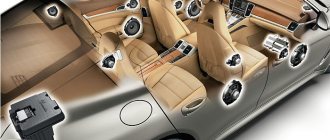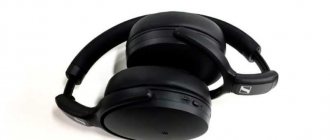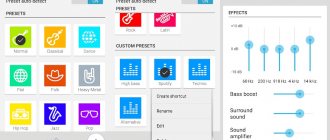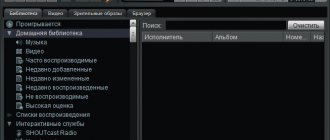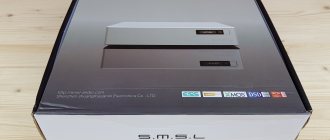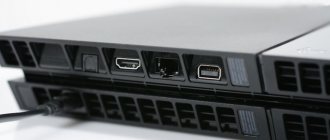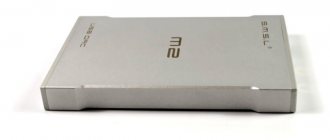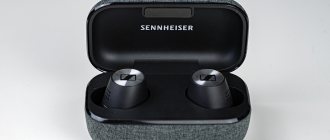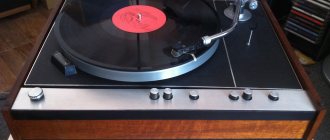SMSL DP3 USB DAC
Digital file player with amplifier and DAC. The body is assembled from aluminum parts. The device is equipped with many connectors: LAN output, Airplay, USB, microUSB, AES, Ethernet input. The player has a Bluetooth module, which allows you to use the device in conjunction with wireless speakers or headphones. Supports modern streaming services, which is very convenient. This is a good device that will be an excellent addition to your home stationary audio system.
Price: US$279.99
SMSL DP3: hi-fi device 3 in 1
Progress does not stand still. The evolution of hi-fi forced me to reconsider the composition of my home system. The transition from physical media to file directories led to the fact that the place of the CD player was once taken by a computer with an advanced sound card, then by a computer with an external DAC, and now the time has come to replace the computer itself with something more consistent with the concept of hi-fi. I immediately dismissed the options for players from well-known hi-fi brands, since even in the budget segment their products almost always disappoint with their price/quality ratio: they look good, but the hardware and capabilities are rather weak. In the higher segment, this gap only widens. And Chinese hi-fi brands, such as Cayin or Soundaware, are also close to the world leaders in price. I already have SMSL AD18 working in my home theater, dubbing films, and I’ve also seen good reviews about their products in general, plus stalker measurements have shown that they approach their products responsibly. In general, I decided to go with SMSL DP3. I bought the device during the sale days, so it cost me less, which pleasantly improves the price/quality ratio for this, already one of the cheapest network audio players. I bought it for myself as a network source player that feeds a signal from the NAS to the DAC. However, in addition to this, this device is a headphone amplifier and an independent DAC. That is, a 3 in 1 device. The appearance and structure of the menu are clearly understood from the product page on Ali and on the official website. Therefore, I will not dwell on this, I will only say that externally the device looks solid and dignified. There is no feeling of tackiness inherent in many Chinese products. There is no shame in keeping it in a rack with the rest of the hi-fi. Specifications
I will dwell more on what I liked and why, and what I didn’t like that is hidden from view or not obvious. to Poogo for the photo of the boards
from the iXBT forum.
So, the first thing I wanted to pay attention to is the power supply.
Here it is built into the main unit of the device. I see my pros and cons in this decision. The advantage is that this allows you to implement more complex power supply: for example, make it bipolar in the power supply itself, use different power circuits both in voltage, and separate the digital and analog power supply. The manufacturer did not use all of this here, except, as it seemed to me, different voltage circuits: 5V and 3.3V. The downside of the built-in unit is the impossibility of upgrading the power supply using simple methods, such as replacing the standard power supply with a better one, including a linear one. The second thing that seems important to me is the direct signal path from the processor to the built-in DAC.
Here, obviously, there is no conversion of the I2S ->USB->I2S signal, as with the asynchronous connection of external DACs. That is, the MCLK signal here is synchronous. The bus goes directly across the board to the DAC chips. It seems to me that this is a very important nuance. That is why I assembled a little earlier and used a combination of Raspberry Pi3 + Allo Boss hat for it, where there was also an attempt to implement a synchronous mode. Here is my review of this solution. Perhaps I do not have very sensitive hearing, but on my average hi-fi system (the NAD C356BEE amplifier was $1000, the HECO Celan GT 502 speakers were $2000), when compared with a combination of computer + DAC Lynx D78 (clone), I hear the difference only at the level of nuances. I think that the reason that an inexpensive Raspberry solution performs comparable to a top-end DIY DAC is, among other things, that the Raspberry set does not have I2S signal conversion. I expect that this will give an increase in quality here too. But I’m going to use the device as a source for an external Lynx D78 DAC (clone) and I expect that the USB output here will work cleaner than that on a computer, if only because nothing else will hang on this bus and the ground it shares ( mice, keyboards, all kinds of devices, etc.), introducing their dirt. The device makes it possible to use it purely as a DAC with an external source. Everything here is more or less standard, but I think you should pay attention to the fact that the USB inputs on the board are not galvanically isolated, which could potentially lead to a decrease in sound quality if the source is a “noisy” device. Listening will tell.
Listening
1. Headphone amplifier. Apparently, the main use case for this device is a desktop player that receives files over the air (or from a storage device) and plays them through headphones. Such an “all in one”. However, just for such a scenario, as I understand it, this device is very poorly suited due to the unsuccessful headphone amplifier. Firstly, I would like to immediately note that the device does not have tone control. At all! And if for linear output this is not critical for me personally (I listen to a direct signal in speakers), then in headphones without timbre the sound becomes flat, there is no mass and volume in it. Secondly, the amplifier is quite weak. At 32 Ohm it produces only 58mW. In principle, there is enough, but there is no power reserve. It may not be suitable for tight headphones with low sensitivity and high impedance. I listened to the amplifier with BlitzWolf® BW-ES2 and Superlux HD-669 headphones. Compared with the ZUK Z2 Pro smartphone. I have no shame in pointing it out as a subject of comparison. The sound of this smartphone is very decent. Previously I tried to become the owner of a hifi player, I bought xDuoo X2, Zishan Z3 and both lost to it. But I don’t see the point in buying more expensive players: their potential won’t be heard in the subway anyway.
So, with the tones turned on on the smartphone, as for me, the amplifier in the SMSL loses in terms of perception as a whole, although, of course, thanks to the presence of a cool DAC, it gives more air and detail in the middle and high parts of the spectrum.
But there is not enough “meat”, and for me this is very critical. If you turn off the tone on your smartphone, then, of course, SMSL sounds better, although there are more low frequencies in the smartphone in this case too. There is a feeling that the frequency response in SMSL in the lower part of the spectrum is overwhelmed. I wrote to SMSL support to add an equalizer to the next firmware, since without it the device was in vain equipped with a headphone output. They replied that they would forward the request to the developers. So perhaps the situation will be corrected with future firmware. By the way, firmware comes out from time to time. The current version is 1.6. No credit for the headphone amplifier.
2. DAC Connected the device to your system. NAD, DIY power amplifier EA2014 (super A class, dual mono) acted as a switch and preamplifier. Compared with a DAC from Lynx (dual mono with AKM Verita 4490EQ DAC on each channel). I liked the sound of SMSL. The characteristic shrillness of the Saber ES9018 in the highs gave the sound lightness and volume. At first it even seemed that SMSL drew the panorama better, the instruments were more clearly located in space. But then I got used to it, began to listen to the other sounds, still no, Lynx sounds more pleasant, although I can’t say that there is a gap between them in terms of sound quality. I'm sure many will prefer the lighter, airier presentation of the SMSL. DAC - pass, definitely!
3. Player Comparing the player as a source turned out to be, one might say, meaningless. While the first comparisons could be done on the fly, simply by clicking buttons on the preamp and switching plugs, here the comparison involved a delay to switch cords. I didn't hear any difference between the player and the source computer. Therefore, I will give the player the main rating for ease of use. Everything is not clear here.
The screen is small, the font is small. Personally, I find it difficult to see this font on the screen. From a distance it's unreal. There are few controls, and many things are hidden in these small menus. For example, if you use the device as a digital source and want to listen to headphones, then there is no quick way to do this: you need to go into the jungle of the menu and switch outputs in it. But for the most part, the menu is only needed for configuration. Set it and forget it. For playback, the player can be controlled from a smartphone via Bluetooth using the HiBy Music application (free on the Market). And the biggest drawback of the firmware is the inability to play a file through all folders from a network device. From a card or flash drive connected to the player - yes. With NAS - no, only inside one folder. Listen to the folder - choose the next one. Moreover, this cannot be done from a smartphone, only from the screen, since Hiby does not see network shares. Poogo enthusiast in the iXBT thread
, which modifies the firmware and fixes some bugs.
True, you will have to write some of the fixes in the firmware yourself to suit your home settings. Therefore, it seems like there is a solution, but still not without hemorrhoids. The player's rating is a C.
CONCLUSIONS
Despite all the disadvantages, I am happy with the purchase.
I hope that some of the shortcomings will be corrected with firmware, since they are all software. The hardware of the player is not bad, it sounds very good, looks nice in appearance, and is compact. Considering all this, I will probably sell my DAC and keep the SMSL. Therefore, I definitely recommend it for purchase. I bought the product with my own money, so this is not an advertisement. However, I contacted the seller from whom I bought and asked for a discount for our site. He gave a coupon that reduces the price by $26, that is, almost 10%. I think it's a very interesting proposal. For the money this is a very good purchase. www.aliexpress.com/store/selected-sale-items/314156.html?spm=5261.10636610.0.0.22223e5fYLPbsk&es=B1RqPWiRoWP%2BQ7a8iJCePNrsb3gxHfpf Link to coupon. Until May 5th. (strange, I copy the link from the supplier’s letter, but here it doesn’t work, it opens his usual coupons, but when I go from the letter, I get to the $26 coupon. Anyone experienced, explain how to give you the coupon correctly?). If the link to the coupon does not work for you, write to the seller USD26 coupon
before payment, he will send you a link. I can use his link to open a coupon, but after inserting it into the site, it stops working. The seller also wrote that since there is a problem with the link, he will send a link to the coupon to everyone who now adds smsl dp3 to the cart.
SMSL DP3 DSD HIFI Digital Network Music Player Headphone Amplifier WIFI ES9018Q2C
SMSL DP3 Network Music Player DSD HIFI Digital Player Headphone Amplifier WIFI ES9018Q2C DAC DSD256 Bluetooth
Since our Russian warehouse is frozen, our parcels will be sent from China by CDEK Express.
Countries that can be shipped through overseas warehouses:
UK, Spain, France, Czech Republic, Italy, Belgium, Netherlands, Poland, Latvia, Sweden, Germany, Ireland, Greece, Finland, Denmark, Portugal, Austria, Bulgaria, Estonia, Hungary , Lithuania, Romania, Slovenia If buyers from the above countries need to ship through overseas warehouses, please contact SMSL customer service, we will arrange delivery for you as soon as possible
- Lossless turntable with balanced headphone amplifier output. DSD uses dual SABRE9018Q2C, which is from USA ESS technology, features high SNR, very low volume and built-in headphone amplifier.
- Support bluetooth 4.0 input and APT-X lossness. Support bluetooth data transmission, can be used to connect bluetooth headset. Support Hiby app to control this product (Hiby Link).
- Support "ISO, APE, FLAC, WAV, ALAC, WMA, AIFF, MP3, DFF, DSD" and many other music files. The sampling rate of these files is up to 32bit/384K(PCM) and DSD256.
- The Micro-USB port can connect to a computer, producing DP3 a USB DAC. DP3 can act as a USB host for connecting an external USB DAC, and also supports DSD streaming.
- Supports network playback (DLNA and AirPlay) via Ethernet and Wi-Fi (2.4G and 5G). Built-in headphone amplifier, both unbalanced and balanced. All digital output paths, coaxial, optical, AES/EBU, even USB.
Sp Characteristics
Input Mode: USB/USB Audio/SD/Bluetooth/DLNA/SAMBA(NAS) Output Mode: Line/Headphone/Optical/Coaxial/AES/Bluetooth/USB THD+N: Line Output 0.0008%, Unbalanced Output 0.0008%, Balanced Output 0.004% Dynamic Range: Line Out 121dB SNR: Line Out, Unbalanced 112dB, Balanced 110dB Headphone Output Power: Unbalanced 58MW (32Ω) 46MW (64Ω) 26MW (150Ω) Balanced 113MW (32Ω) 110MW(64Ω) 78MW(150Ω) 49MW(300Ω) Line Output Level: 2Vrms USB Audio: Top Support DSD DSD256 PCM, Top Support PCM384khz
Notes : When using airplay, the airplay buffer is quite small, so it is often affected by the Wi-Fi environment.
Therefore, it is necessary to create a good Wi-Fi environment.
ZUOYA Wired Gaming Mouse
A good wired mouse with a laser sensor and a great design that will please any gamer. Thanks to the ergonomic body, the mouse fits like a glove in the palm of your hand. It has side buttons that are very convenient to press. The mouse does not slip in the palm of your hand due to the special galvanic coating. Optical resolution: 1200/1800/2400/3200 DPI. Weighs 145 g.
Price: US$8.89
Mini power bank 10,000 mAh
Portable power bank with 10,000 mAh capacity, designed for charging electronic devices such as smartphones, tablets, etc. Supports fast charging function. Thanks to its small dimensions, it fits easily into a pocket, making the power bank convenient to carry with you. Equipped with two USB ports, TYPE-C, lighthing. There is a small display that shows the percentage of charge remaining.
Price: US $12.99 – 13.99

